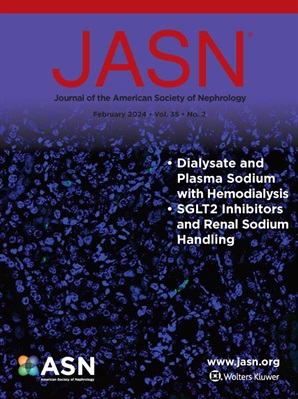Genome-Wide Association Study of Plasma Sodium Concentrations with and without Exposure to Thiazide Diuretics.
IF 10.3
1区 医学
Q1 UROLOGY & NEPHROLOGY
Journal of The American Society of Nephrology
Pub Date : 2025-06-01
Epub Date: 2025-01-31
DOI:10.1681/ASN.0000000622
引用次数: 0
接触噻嗪类利尿剂前后血浆钠浓度的全基因组关联研究。
背景:血浆钠浓度异常代表了全身水分相对于电解质含量的不平衡。低钠血症是一种常见且潜在的严重不良事件,噻嗪类利尿剂是引起药物性低钠血症的主要原因。方法:我们对188,464名欧洲血统的个体进行了血浆钠浓度、噻嗪引起的钠浓度下降和噻嗪引起的低钠血症的全基因组关联研究分析。此外,我们测试了多基因评分对血浆钠浓度和噻嗪暴露对钠浓度和低钠血症风险的影响之间的基因-环境相互作用。结论:这些结果强调了遗传变异在调节血浆钠浓度中的作用,并强调了涉及垂体的途径的重要性,而没有发现噻嗪类药物降低血浆钠作用的遗传易感证据。
本文章由计算机程序翻译,如有差异,请以英文原文为准。
求助全文
约1分钟内获得全文
求助全文
来源期刊
CiteScore
22.40
自引率
2.90%
发文量
492
审稿时长
3-8 weeks
期刊介绍:
The Journal of the American Society of Nephrology (JASN) stands as the preeminent kidney journal globally, offering an exceptional synthesis of cutting-edge basic research, clinical epidemiology, meta-analysis, and relevant editorial content. Representing a comprehensive resource, JASN encompasses clinical research, editorials distilling key findings, perspectives, and timely reviews.
Editorials are skillfully crafted to elucidate the essential insights of the parent article, while JASN actively encourages the submission of Letters to the Editor discussing recently published articles. The reviews featured in JASN are consistently erudite and comprehensive, providing thorough coverage of respective fields. Since its inception in July 1990, JASN has been a monthly publication.
JASN publishes original research reports and editorial content across a spectrum of basic and clinical science relevant to the broad discipline of nephrology. Topics covered include renal cell biology, developmental biology of the kidney, genetics of kidney disease, cell and transport physiology, hemodynamics and vascular regulation, mechanisms of blood pressure regulation, renal immunology, kidney pathology, pathophysiology of kidney diseases, nephrolithiasis, clinical nephrology (including dialysis and transplantation), and hypertension. Furthermore, articles addressing healthcare policy and care delivery issues relevant to nephrology are warmly welcomed.

 求助内容:
求助内容: 应助结果提醒方式:
应助结果提醒方式:


